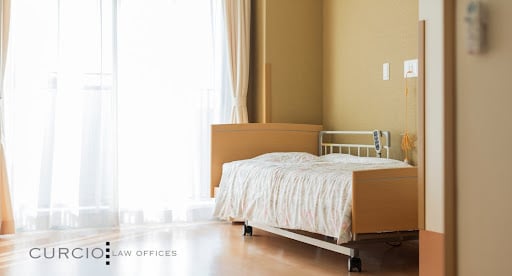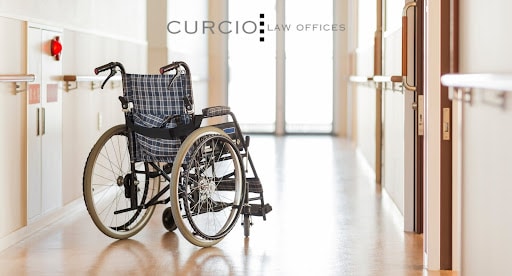Chicago Nursing Home Bed Sores Attorneys
PRACTICE AREAS
Chicago Bed Sore Lawyer
Hospitals and nursing homes should be safe places for rest and healing. Unfortunately, this is not always the case due to elder abuse and neglect. Nursing home abuse and neglect can manifest in many different ways, including bedsores and Chicago nursing home falls. For example, you may notice your elderly loved one suffers from frequent broken bones, unexplained bruises, poor hygiene, and even severe bed sores. If you believe that your loved one is suffering more than they’re healing in a nursing home, it’s time to call Chicago bed sore lawyers at Curcio & Casciato. We will carefully review the details of your case and fight for your elderly relative’s health, happiness, and justice. Call us today at 312-321-1111 for a free consultation. A nursing home abuse attorney Chicago with our firm stands ready to represent you and your loved ones.

What is a Bed Sore?
A bed sore – also called a pressure sore or a pressure ulcer – is a common deep tissue injury that older adults can suffer from while in nursing homes and hospitals.
How Do Bed Sores Happen?
Pressure sores most commonly form on body parts that sustain prolonged pressure from a bed or a chair. More specifically, pressure sores happen when pressure cuts off the skin’s blood flow for upwards of three hours. When pressure cuts off blood supply, the healthy skin and underlying tissue can die.
Pressure injuries are prevalent among nursing home residents because many spend their entire days lying in the same position due to lack of mobility or chronic illness. Hospital patients and those healing from major surgeries at home are also at risk of pressure ulcer development.
Symptoms of Bed Sores
The first symptoms of pressure ulcers are skin color and texture changes. Light skin will generally turn pink or red, while dark skin turns purple or blue. Pressure wounds will also feel hard, warm, or spongy. As pressure ulcers develop, the skin may break, bleed, or release fluid. Without treatment, pressure injuries can certainly lead to infection. Symptoms of bed sore infection generally include fever, green or black coloring in the surrounding skin, and more pus from the wound.
Common Locations of Bed Sores
Pressure ulcers most commonly occur in areas of the body that receive constant pressure, creating poor blood circulation in the skin. So if someone sits in one position all day, they can develop bed sores in bony areas such as:
- Tailbone and buttocks
- Spine
- Behind the arms or legs
- Shoulder blades
Meanwhile, a person who spends all day lying in bed may suffer from pressure ulcers in the following areas:
- Back of the head
- Elbows
- Tailbone
- Shoulder blades
- Heels
- Ankles
Stages of Bed Sores
In terms of pressure ulcer staging, pressure ulcers will generally develop in four stages:
- Stage 1 Bedsore: The skin’s surface may feel warm and may look discolored. The area may also be itchy.
- Stage 2 Bedsore: The wound will break open and bleed. The skin may appear discolored around the open wound.
- Stage 3 Bedsore : The open wound may look like a crater because of the tissue damage happening under the skin.
- Stage 4 Bedsore: The large wound may develop an infection. It may also be possible to see bones, muscles, and tendons beneath the wound.
Can Someone Die From a Bed Sore?
It’s certainly possible for a person to die from a pressure ulcer. The stage four bedsore life expectancy isn’t bright. This generally happens when an untreated pressure ulcer reaches stage three or stage four because the infection is incredibly common during these stages. In fact, according to the Agency for Healthcare Research and Quality (AHRQ), pressure ulcers cause more than 60,000 deaths every year in the United States. Sometimes, deaths caused by pressure ulcers can fall under the umbrella of wrongful death if:
- Someone should have prevented the bed sore
- Someone could have treated the bed sore at stage one or two
- There is substantial proof that the cause of death was a severe pressure sore
Treating Pressure Sores
The best way to treat developing bedsores in an assisted living facility or hospital is to relieve pressure, which supports healthy blood flow. Nurses in assisted living facilities generally achieve this by helping bedbound patients change positions every few hours or propping up affected body parts on foam pads. Other ways to treat developing pressure sores are listed below.
- Keep the Skin Clean: If someone develops a bedsore, it’s crucial to clean the wound and the surrounding skin to prevent infection. Nurses may do this with water and mild soap. For open wounds, nurses may use saline solution in between dressings.
- Use Dressings: This is especially important for protecting open wounds and keeping them clean. The best dressings for pressure ulcers are antimicrobial or hydrocolloid.
- Skin Care With Topical Creams: Nurses may use antibacterial creams to prevent infection while the sores heal.
- Removing Dead Tissue is important to aid in the healing process. A doctor may remove dead tissue with surgical tools or a water jet.
- Change the Bedding: Mattresses made of static foam can prevent hospital-acquired pressure ulcers by promoting proper blood circulation. Talk to a doctor about which kind of mattress they recommend for you or your loved one.
- Take Antibiotics: Antibiotics are the best way to treat infections of any kind.
- Address Poor Nutrition: A healthy, balanced diet won’t solve or prevent pressure ulcers on its own. However, ensuring that chronically ill or elderly patients consume essential nutrients every day can improve the body’s response to healing wounds and fighting infection.
Our Chicago medical malpractice attorneys are well-versed in antibiotic stewardship for nursing homes. If your loved one developed bed sores as a result of this medical negligence, our Chicago nursing home infections lawyer can help.
Preventing Pressure Ulcers
Pressure ulcer prevention and treatment go hand in hand for bedbound people in living facilities. Some of the aforementioned treatments are also prevention methods. To prevent a pressure-induced injury, nurses and nursing homes must:
- Change their patient’s positions every two to three hours
- Inspect their patient’s skin every day
- Maintain proper skincare by cleaning it and keeping it dry
- Enforce proper nutrition for all patients
- Prohibit smoking for all patients
- Encouraging regular exercise, even for bedbound patients, to improve blood flow
Malnutrition in Chicago nursing homes has become a major concern lately. Don’t assume that your loved one is being properly fed and hydrated.
How Common are Bed Sores in Nursing Homes?
1 in 10 patients in assisted living facilities develop bedsores. The CDC also determined that stage two ulcers were the most common and that 35% of elderly people with stage two (or more severe) needed special treatment from a wound care team.
More recent research from the ACP in 2015 says that 3 million Americans suffer from pressure injuries every year, and those who are immobile are the most at risk. The complications of immobility in nursing homes cannot be overstated.
Why Should I Pursue Legal Action for a Pressure Injury?
Many families of seniors file lawsuits for bed sores with our Chicago elder abuse lawyers because they can be a symptom of elder abuse. Medical facilities and nursing homes are required to provide optimum care for their patients. This means that one of their main priorities, especially for senior patients and bedbound patients, is to prevent bedsores. In many cases, a pressure ulcer lawsuit is based on the legal theory of negligence.
In fact, stage three and four pressure ulcers are included on a list of “never events” from the Centers for Medicare and Medicaid Services (CMS). Basically, this means that while stage one and stage two pressure ulcers aren’t always preventable, stage three and stage four pressure ulcers are certainly preventable and should never happen. Therefore, Medicaid will not pay for the medical bills associated with a severe pressure injury.
Social services cannot force an elderly person into a retirement home or assisted living facility. Your family or loved one is paying for negligent care each month.
How to Win a Pressure Ulcer Lawsuit
If your loved one in a nursing home has suffered multiple stage three and stage four decubitus ulcers, your case will likely be worth more than if your loved one suffered from multiple stage one or stage two ulcers. The first step in potentially winning a pressure-sore lawsuit is to hire experienced elder abuse lawyers at Curcio & Casciato. We have decades of combined experience in fighting against all types of abuse in nursing homes.
Proving Negligence
The next step in potentially winning a pressure sore lawsuit is to prove the elements of negligence, but only if you believe that is the direct cause of your loved one’s pressure ulcers. Negligence is the failure to take appropriate care of someone or something, and the most successful negligence lawsuits prove the four d’s of negligence:
- Duty of Care: The nursing home or the nurse/doctor in charge owed all of their patients a specific duty of care. In other words, the facility or the nurse/doctor must take proper care of all of their patients.
- Violating Duty of Care: The nursing home or the nurse/doctor in charge of your loved one failed to properly prevent a pressure-induced injury. Additionally, once the facility or nurse/doctor noticed their patient developing bedsores, they didn’t take care of it before it progressed into a stage three or four pressure ulcer.
- Causation: The elderly person suffered severe pain, injury, infection, nerve damage, or death because of their pressure sores, which directly resulted from a violated duty of care.
- Damages: Compensation from the nursing home, nurse, or doctor would partially or totally cover the cost of extensive bed sore treatment.
Chicago bed sore lawyers at Curcio Law can certainly help you gather enough evidence to prove these elements of negligence.
Average Bed Sore Lawsuit Compensation Amounts

The NCBI released a study that assessed medical malpractice claims associated with pressure ulcers from 1987 to 2019. The study concluded that:
- The mean compensation for claims involving individual providers was $400,000,
- The mean compensation for claims involving nursing homes was between $4 million to $7.75 million,
- And the mean compensation for claims involving hospitals was between $1.59 million and $2.48 million.
Additionally, nearly 80% of the pressure ulcer cases involved in this study were for negligence, while only 22% were for medical malpractice. When these pressure ulcer cases went to trial, the family of the senior (the plaintiff) won 35% of the time while the facility, doctor, or nurse (the defendant) won 36% of the time. Lastly, only 26% of the pressure ulcer cases involved in this study resulted in a settlement.
Call Chicago Bed Sore Lawyers at Curcio Law Today
At Curcio & Casciato, we want to make nursing homes and hospitals safer, more comfortable places for senior citizens. Hospitals and nursing homes are supposed to be places of healing and rest, not a place where older adults go to suffer life-threatening pressure sores. That’s why our Chicago bed sore lawyers are so passionate about fighting for elderly patients in nursing homes. Our Chicago medical malpractice lawyers want to make every assisted living facility a safer place for your elderly relative, one elder abuse lawsuit at a time. Call us today at 312-321-1111 for a free consultation.


